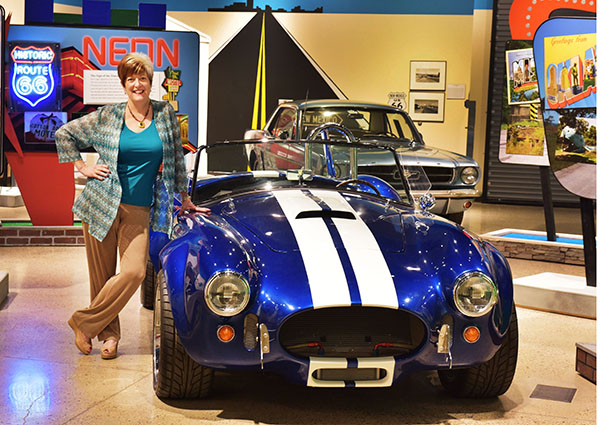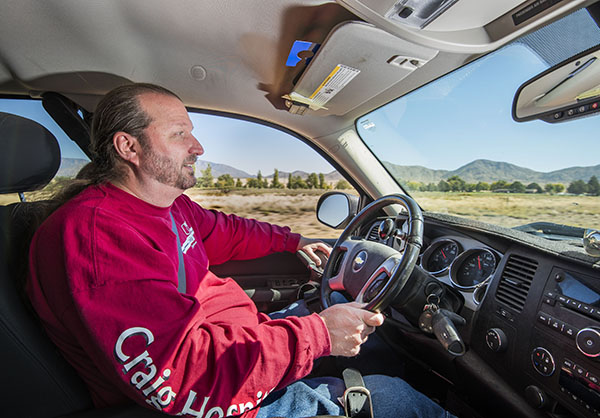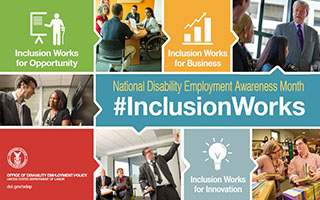I chose a different path
Becky Krauss shares her story of an Invisible Chronic Illness

Becky Krauss, director of Communications Center 3600, lives with relapsing, remitting multiple sclerosis. “Having the support of people who understand that even though you look fine you might not feel fine is a great source of strength,” Becky says. (Photo by Randy Montoya)
See also: The road taken: Kirk Graham forges a new life after accident
By Becky Krauss, Director of Sandia Communications Center 3600
I have an Invisible Chronic Illness. To an unknowing observer, I appear healthy and, dare I use the word, “normal.” But on the inside, at any given time, I might be feeling numbness or tingling in my hands or feet, intense fatigue, dizziness, or, my most common symptom, an intolerance of heat. In a hot, stuffy room, I can feel like my whole nervous system is shutting down.
In 1998, I was diagnosed with relapsing remitting multiple sclerosis. It was devastating and scary, especially when my first doctor recommended I quit my job. I chose a different path.
I was a Sandia lawyer, a wife, a mom. Why would I bench myself? Instead, I had to accept my new self and learn how to live with my new reality.
First, medication. While that involves injecting myself three nights a week (it’s better than it used to be — when it was every night!), my medicine has significantly reduced my symptoms.
Having MS is like having one box of matches per day. Each matchstick is a unit of energy. When you use up your matches, you can’t replenish until the next day.
Second, understand my new limitations. When I was first diagnosed, I took a class offered by the National Multiple Sclerosis Society to learn about MS, get tips, and develop coping strategies. One teacher gave an analogy that made a huge impact on me. For those suffering with chronic fatigue, he said having MS is like having one box of matches per day. Each matchstick is a unit of energy. When you use up your matches, you can’t replenish until the next day. People without MS can grab extra matchboxes each day — with a little rejuvenation, they can reenergize. But because people with MS can’t do that, they really have to plan how they will use their matches during the day, how soon their matchbox will be empty, and what they will do when the matches are gone.
A great source of strength
I have taken that advice to heart and try my best to preplan my day: What will my schedule be? (will it be an exhausting day?); what will I wear? (can I wear my favorite pair of high heels or will that sap my energy?); will I be in a place where it will be too hot for me? (I know where every thermostat is in every conference room and office I frequent. For those of you who feel like you’re in a meat locker when meeting with me, now you know why. I apologize to you for your shivering, but I need the cold air!)
Third, surround myself with support. I made the decision early on that while I would not publicize my illness, I would not keep it a secret. Did I worry whether telling people I have MS would hurt my career? Yes, but I decided it was a chance I had to take. Coping with invisible symptoms is hard enough. Having the support of people who understand that even though you look fine you might not feel fine is a great source of strength.
I think I can speak for most people with ICIs that we don’t want people watching us, waiting to see some sign of how we are feeling so they can help. I may feel pins and needles inside my body from time to time, but I don’t want my family or friends to be on pins and needles waiting to see if one of my symptoms is going to flare up. Of course it is OK to ask me how I am feeling. That is a sign of caring, not overbearing. But on the whole, I know that it is up to me to ask for help.
I know that might sound contradictory. I know it might be difficult to understand how someone like me wants to be treated. My advice — ask. If someone you care about is willing to tell you she has an ICI, then chances are good you can have a deeper conversation about how she wants to be supported.
I have never had cause to regret telling people. My family gives me comfort and strength. My friends keep me optimistic. My managers have accommodated me and never underestimated my abilities. My co-workers give me confidence that if I ever need help in a meeting, on a trip, even in the parking lot, I will get it.
Deciding whether to tell others about an Invisible Chronic Illness is a very personal decision. For me, having people know has been a source of strength and comfort. I’m glad I am not alone, even when others are shivering in the cold next to me. Hot coffee is on me!
The road taken
Kirk Graham forges a new life after accident

Kirk Graham knew that after a disabling motorcycle accident he had a choice: He could either start living and take control of his disability, or let it take control of him. Kirk chose to take control of his disability right from the start. He has praised Sandia for the extent to which it has made accommodations in the workplace to enable him to succeed. (Photo by Randy Montoya)
By Stan Mathews
On Sept. 13, 2007, Kirk Graham’s life changed forever while riding his motorcycle on the curvy Highway 60 near Mountainair, New Mexico. His only memory is that the road turned and he didn’t.
As a result of the accident, Kirk spent several months in the hospital recuperating and getting used to a new normal: life in a wheelchair, paralyzed from the waist down. He wondered how he was going to get back to work at Sandia, where he had worked as a product quality technologist since 2004.
October is Disability Awareness Month, which celebrates the valuable contributions individuals with disabilities make in the workforce and highlights the importance of diversity in the workplace. To reflect the important role disability plays in workforce diversity, the US Department of Labor’s Office of Disability Employment Policy has made #InclusionWorks the theme of this year’s National Disability Employment Awareness Month.

At Sandia, employees with both visible and invisible disabilities make key contributions in organizations across the Labs every day.
Kirk Graham (2719-1) has a visible disability, but he has never let that slow him down. Even at the hospital, as he came to grips with his disability, Kirk knew that he had a choice: He could either start living and take control of his disability, or let it take control of him. Kirk chose to take control of his disability right from the start.
To help Kirk and his family adjust emotionally and mentally to his new situation, the hospital offered a special class that showed everyone how to cope and deal with disabilities.
“It was a very different kind of class,” says Kirk, adding that, “I had been going to a Bible fellowship since the 1990s; the individuals in the fellowship, my family, and my love for God is what got me through my accident and the tough times.”
Kirk’s newfound spirituality and this class changed his perception of being an individual with a disability and helped him overcome depression, a common challenge of those recovering from serious injuries.
Kirk knew he was going to have to make adjustments at home. “My accident affected my whole family to one degree or another,” he says. With the help of his family — his wife, three daughters, sons-in-law, and his five grandchildren — his house was reconfigured so that he could easily move around in his wheelchair without bumping or smashing into anything.
Voluntarily self-identifying
Kirk also knew that adjustments needed to be made at work and that he needed accommodations to be successful at his job. His manager, Lorraine Sena-Rondeau (2719), immediately reached out to the Equal Employment Opportunity (EEO)/Affirmative Action (AA) organization. Kirk filled out a form to self-identify as a person with a disability and submitted it electronically in the Sandia system. Tammy Sanchez-Godin (3011), the Sandia job accommodation specialist (JAS) says, “Voluntarily self-identifying is a good thing — it’s how things change. Sandia supports and encourages employees to self-identify. The process of self-identification is really simple and easy. It is confidential, and is not reported to your manager or anyone else.”
People only see the wheelchair and do not know the person in the wheelchair.
Kirk, Lorraine, EEO & AA, and Facilities worked as a team to reconfigure his work area. Tammy says, “I consult with Sandia Medical to clarify medical restrictions and act as a liaison between management and all on-roll employees to help them participate in discussions to identify reasonable accommodations that will allow employees to perform their jobs.”
Kirk’s office was completely reconfigured to remove any obstacles.
“Sandia has done a tremendous job setting up reasonable accommodations for me,” he says, noting that he has plenty of room to move around his office in his wheelchair, has a sit-stand desk, and Americans with Disabilities Act-accessible doors, both inside and outside the facility, for him. He is also able to drive his wheelchair-accessible, full-sized pickup truck or his classic 1968 El Camino on site and park right next to his office.
Those accommodations have helped him succeed and remain a key contributor at the Labs — he became a Principal Technologist in 2015.
The person in the wheelchair
Lorraine says, “Kirk has consistently demonstrated an amazing work ethic. He doesn’t let his disability get in the way of doing his job. He comes to work every day, is very dedicated and hardworking, and doesn’t ask for any special treatment. He expects to carry his portion of the workload for whatever project he is working on.” His co-workers feel the same way. “Kirk is a hard worker and a very positive person. He is very appreciative of what Sandia has done for him,” says one colleague.
Kirk has taken the concept of reconfiguring to a whole new level. With the help of his family, Kirk built an accessible home in the East Mountains. It took a few years to design, create, and build, its completion marking the culmination of a life-long dream to build his own home.
Kirk knows and understands that when people see him, they immediately see his wheelchair and view him as an individual with a disability. He says, “People only see the wheelchair and do not know the person in the wheelchair.”
His grandchildren have opened his eyes in this respect. Kirk says, “It is awesome to see how aware my family and my grandchildren are of the special needs of a handicapped person — seating at a movie theater, table height at a restaurant, and especially handicapped parking. They all see the difficulty that I have and remember it.”
Kirk can’t get back on his Harley . . . yet. But he can still work with his hands and have a normal life.
“My life is good, I get to work on classic cars — it just takes more time and some help — and I get to play with my grandchildren,” he says. “Life cannot get much better than that.”